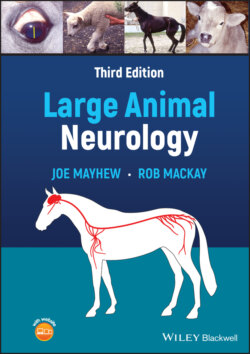Читать книгу Large Animal Neurology - Joe Mayhew - Страница 78
General histologic reactions of cells of the nervous system
ОглавлениеOf some importance in histologic interpretation are occult and aging changes that can be quite impressive.10–12 These include the presence of polyglucosan accumulations or Lafora bodies in cattle,13 cerebrovascular siderosis,14 mineralization,15 dense microspheres and axonal spheroids in adult, and especially aged animals16 and processing‐related neuropil vacuolation,17 all in the CNS. Peripheral nerves do show a depletion of large myelinated fibers with aging,18,19 and normal equine nerves often contain a few to spectacular concentrations of Renaut bodies (Figure 4.6).20,21 Although when profuse, these latter structures may indicate sites of pressure on, or tension of, nerves.22 Equine skeletal muscle can contain many nonpathological degenerative sarcoplasmic masses.23
Figure 4.5 The recommended planes of sections to be taken for histologic examination at each selected spinal cord site are depicted here. [WM = white matter; GM = gray matter]. At the center is the standard transverse plane section. Additional routine histologic sections to be taken on the dorsal plane (left and right) and the sagittal plane (bottom) are strongly recommended. The major sensory (↑) and motor (↓) tracts that allow detection of where a lesion(s) is located are indicated by arrows.
Figure 4.6 Renaut bodies (arrows) may be described as often forgotten endoneural structures seen here on routine low power histologic view of a sciatic nerve fascicle of a horse. They consist of loose connective tissue substances often arranged in loose whorls on transverse section, containing little collagen and few nuclear remnants. Usually they are in a subperineural location where they can occupy a large proportion of space in a fascicle (arrow heads). These normal structures in equine peripheral nerves do not appear to represent pathologic processes by themselves and should not be misinterpreted as pathologic in their own right on pathology reports. However, Renaut bodies can accumulate dramatically and appear to distend nerves undergoing changes such as pressure‐induced neuronal fiber atrophy as occurs with suprascapular nerve entrapment.
An understanding of the ways that cells of the nervous system respond to pathologic and artefactual insults is paramount to the clinical interpretation of pathology reports.()
A précis of the recognized pathologic responses by cells in neural tissues thus follows.
